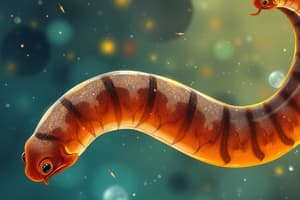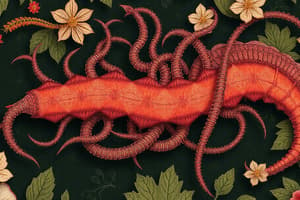Podcast
Questions and Answers
What does the phylum Platyhelminthes include? (Select all that apply)
What does the phylum Platyhelminthes include? (Select all that apply)
- More than 34000 species (correct)
- Sponges
- Flatworms (correct)
- Bilateral acoelomates (correct)
Name the four classes in the phylum Platyhelminthes.
Name the four classes in the phylum Platyhelminthes.
Turbellaria, Monogenea, Trematoda, Cestoidea
Describe the class Turbellaria.
Describe the class Turbellaria.
Mostly free living and aquatic; external surface usually ciliated; predaceous; possess rhabdites, protrusible proboscis, frontal glands, and many mucus glands; mostly hermaphroditic. Includes Convoluta, Notoplana, and Dugesia. More than 3000 species.
Describe the class Monogenea.
Describe the class Monogenea.
Describe the class Trematoda.
Describe the class Trematoda.
Describe the subclass Aspidogastria.
Describe the subclass Aspidogastria.
Describe the subclass Digenea.
Describe the subclass Digenea.
Describe the class Cestoidea.
Describe the class Cestoidea.
Describe the subclass Cestodaria.
Describe the subclass Cestodaria.
The subclass Eucestoda includes _____ species.
The subclass Eucestoda includes _____ species.
Flashcards are hidden until you start studying
Study Notes
Overview of Phylum Platyhelminthes
- Comprises flatworms, bilateral acoelomates, with over 34,000 species.
Classes in Phylum Platyhelminthes
- Four main classes: Turbellaria, Monogenea, Trematoda, and Cestoidea.
Class Turbellaria
- Predominantly free-living and aquatic organisms; external surfaces are usually ciliated.
- Characterized by predatory behavior and the presence of rhabdites, protrusible proboscis, frontal glands, and numerous mucus glands.
- Reproductive mode is mostly hermaphroditic.
- Notable examples include Convoluta, Notoplana, and Dugesia, counting over 3,000 species.
Class Monogenea
- Consists of flukes, primarily ectoparasites found on vertebrates, especially fish, as well as occasional hosts like turtles and frogs.
- Lifecycle involves a single host with one form.
- Distinguished by the presence of an opishaptor.
- Includes species such as Disocotyle, Garodactylus, and Polystoma, with approximately 1,100 species.
Class Trematoda
- Entirely parasitic with complex life cycles featuring both sexual and asexual reproduction.
- Subdivided into two subclasses: Aspidogastria and Digenea.
- Comprises more than 10,000 species.
Subclass Aspidogastria
- Mainly endoparasites of mollusks; characterized by a large opishaptor and typically lack an oral sucker.
- Notable examples include Aspidogaster, Cotylapsis, and Multicotyl, with around 32 species.
Subclass Digenea
- Contains adult endoparasites in vertebrates, requiring multiple hosts with at least two lifecycle forms.
- Features an oral sucker and acetabulum.
- Includes significant species like Schistosoma, Fasciola, and Clonarchis, totaling about 1,350 species.
Class Cestoidea
- Entirely parasitic organisms, notably lacking a digestive tract and exhibiting significant reproductive potential.
- Commonly known as tapeworms; categorized into two subclasses: Cestodaria and Eucestoda, with around 3,500 species.
Subclass Cestodaria
- Body structure is not divided into proglottids; larval forms inhabit crustaceans while adults live in fishes.
- Examples include Amphilina and Gyrocotyle, totaling about 15 species.
Subclass Eucestoda
- Details on this subclass are unspecified in the provided text.
Studying That Suits You
Use AI to generate personalized quizzes and flashcards to suit your learning preferences.




